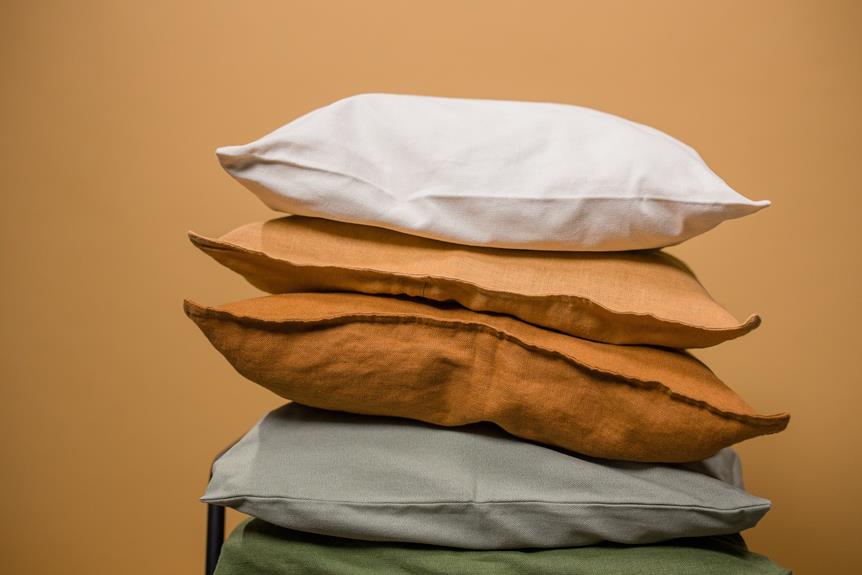So, you've decided to take on the challenge of reupholstering your beloved wingback chair.
But before you dive into the world of fabric swatches and upholstery tools, you'll need to figure out just how much fabric you'll require for the job.
It's a bit like measuring ingredients for a recipe – too little, and you'll come up short, too much, and you'll have excess fabric hanging around.
In this guide, we'll walk you through the steps to accurately calculate the yardage needed for your wingback chair project, ensuring that you have just the right amount to bring your vision to life.
Key Takeaways
- The dimensions of the chair, including width, height, seat depth, cushion thickness, and curvature of the arms and back, should be assessed before determining the fabric yardage needed.
- When calculating fabric yardage, consider the width of the chair, type of fabric, pattern repeats, and any additional yardage required for upholstery details like tufting or piping.
- Pattern matching is important for a cohesive look, so factor in additional yardage needed for pattern repeats and select fabric based on pattern repeat and fabric width.
- Consider factors such as durability, ease of maintenance, matching existing decor and style, texture, and comfort when choosing fabric, and estimate costs based on chair dimensions and additional fabric needs.
Assessing the Chair's Dimensions
To determine the fabric needed for reupholstering your wingback chair, measure its dimensions accurately before starting the project. Measuring accurately is crucial for ensuring you have enough fabric to cover the entire chair.
Start by measuring the width of the chair from the widest point of one arm to the other. Then, measure the height from the top of the backrest to the seat cushion. Understanding proportions is also essential. Take into account the depth of the seat, the thickness of the cushion, and the curvature of the arms and back.
These measurements will help you calculate the amount of fabric required to cover the chair adequately without running short. Accuracy is key, so it's a good idea to double-check all measurements before purchasing your fabric.
Calculating Fabric Yardage
Start by measuring the width of your wingback chair from the widest point of one arm to the other, as this will help you in calculating the fabric yardage required for reupholstering. When it comes to reupholstering your wingback chair, accurately calculating the fabric yardage is crucial.
Here's how to do it:
- Measure the widest part of the chair: Start by measuring the widest point of your wingback chair, typically from one arm to the other. This will give you the width measurement needed for fabric calculation.
- Consider the fabric type: Different fabric types have varying widths, so consider the type of fabric you plan to use for reupholstering. This will impact the yardage required.
- Account for pattern repeats: If your chosen fabric has a pattern that needs to be matched, you may need additional yardage to ensure seamless continuity.
- Factor in extra for upholstery details: If your chair has tufting, piping, or any other intricate details, remember to add extra yardage to accommodate these features.
Factoring in Pattern Repeats
When factoring in pattern repeats for reupholstering your wingback chair, consider the additional yardage needed to ensure seamless continuity of the design. Pattern matching is crucial when selecting fabric for your wingback chair. It ensures that the pattern aligns perfectly across the different sections of the chair, creating a cohesive and professional look. To understand how pattern repeats affect your fabric requirements, refer to the table below:
| Fabric Width (inches) | Pattern Repeat (inches) | Additional Yardage Needed |
|---|---|---|
| 54 | 12 | 1.5 |
| 60 | 18 | 2 |
| 72 | 24 | 2.5 |
As seen in the table, the wider the fabric width and the larger the pattern repeat, the more additional yardage is required to ensure proper pattern matching. When selecting your fabric, keep in mind the pattern repeat and the width of the fabric to accurately calculate the total yardage needed for your wingback chair. This attention to detail will elevate the final result and showcase your mastery of fabric selection for reupholstering projects.
Considering Additional Fabric Needs
Once you have factored in pattern repeats for reupholstering your wingback chair, you must also consider any additional fabric needs to ensure a seamless and professional finish.
When it comes to sourcing quality fabric for reupholstering, consider the following:
- Durability: Look for fabric that's durable and easy to maintain, especially if the chair will be used frequently.
- Color and Pattern Matching: Ensure that the fabric you choose matches the existing decor and style of the room.
- Texture and Comfort: Consider the texture and comfort of the fabric to ensure it complements the design and provides a comfortable seating experience.
- Estimating Costs: Calculate the total fabric needed based on the dimensions of your wingback chair and the additional fabric required for things like piping, matching patterns, or creating a cohesive look with other furniture pieces.
Tips for Minimizing Waste
To minimize waste when reupholstering your wingback chair, carefully plan your fabric layout to optimize cutting and reduce excess material. By doing so, you can reduce scraps and contribute to eco-friendly options. Here are some tips to help you minimize waste and make the most of your fabric:
| Tip 1: | Take precise measurements |
|---|---|
| Measure your chair accurately to determine the exact amount of fabric you need. This will help you avoid purchasing more fabric than necessary, reducing waste in the process. | |
| Tip 2: | Create a cutting plan |
| Before cutting your fabric, create a layout plan to ensure you use the fabric efficiently. Consider the pattern, direction of the fabric, and placement of pieces to minimize waste and maximize coverage. | |
| Tip 3: | Consider eco-friendly options |
| Look for sustainable and eco-friendly fabric options. Some fabrics are made from recycled materials or produced using environmentally friendly processes, which can align with your goal of minimizing waste and reducing your environmental impact. | |
Frequently Asked Questions
Can I Use Different Fabrics for Different Parts of the Chair, or Should I Use the Same Fabric for the Entire Reupholstering Project?
You can absolutely use different fabrics for various parts of the chair. Just consider fabric pattern continuity for a cohesive look. Mixing textures and colors can add visual interest, so feel free to get creative!
What Are Some Common Mistakes to Avoid When Calculating Fabric Yardage for Reupholstering a Wingback Chair?
When calculating fabric yardage for reupholstering, common mistakes include not accounting for pattern repeats, underestimating for matching patterns, and forgetting about different fabrics for various parts. Be mindful to avoid these errors.
Are There Any Specific Types of Fabric That Are Better Suited for Reupholstering a Wingback Chair?
When reupholstering a wingback chair, fabric durability is crucial for longevity. Chair style influences fabric choice, and color coordination and texture selection are important for aesthetics. Consider these factors for a successful reupholstery project.
How Can I Determine if a Fabric Pattern Will Work Well With the Shape and Style of a Wingback Chair?
To determine if a fabric pattern will work well with the shape and style of a wingback chair, consider color coordination and fabric texture. Opt for patterns that complement the chair's style and enhance its aesthetic appeal.
Are There Any Special Considerations for Reupholstering a Vintage or Antique Wingback Chair, Compared to a Newer Chair?
When reupholstering an antique wingback chair, consider historical preservation and fabric selection. Upholstery challenges may differ between antique and modern chairs. Preserve the chair's unique character and style while choosing a fabric that complements its historical significance.
- Can You Use Coconut Oil as a Fabric Softener? The Truth Revealed - June 29, 2025
- DIY Coconut Oil Fabric Softener: A Natural Recipe - June 29, 2025
- Your Guide to Buying Snuggle Coconut Milk & Honey Fabric Softener - June 29, 2025







